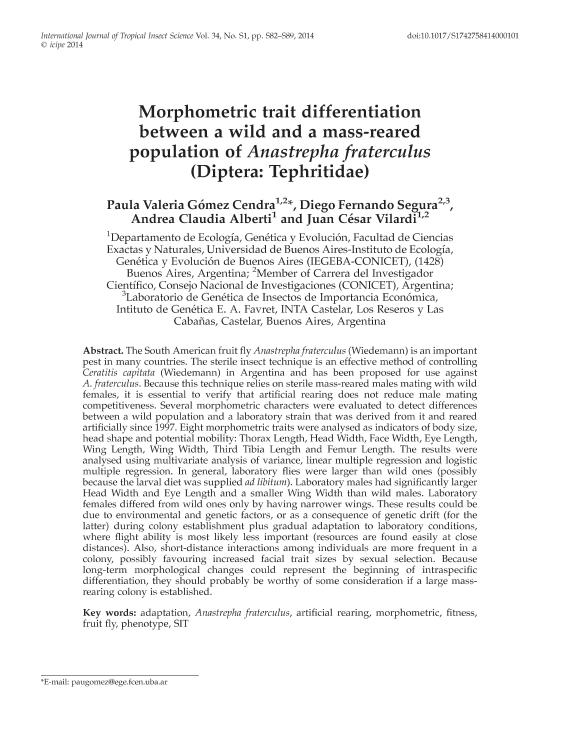Artículo
Morphometric trait differentiation between a wild and a mass-reared population of Anastrepha fraterculus (Diptera: Tephritidae)
Fecha de publicación:
10/2014
Editorial:
Cambridge University Press
Revista:
International Journal of Tropical Insect Science
ISSN:
1742-7584
Idioma:
Inglés
Tipo de recurso:
Artículo publicado
Clasificación temática:
Resumen
The South American fruit fly Anastrepha fraterculus (Wiedemann) is an important pest in many countries. The sterile insect technique is an effective method of controlling Ceratitis capitata (Wiedemann) in Argentina and has been proposed for use against A. fraterculus. Because this technique relies on sterile mass-reared males mating with wild females, it is essential to verify that artificial rearing does not reduce male mating competitiveness. Several morphometric characters were evaluated to detect differences between a wild population and a laboratory strain that was derived from it and reared artificially since 1997. Eight morphometric traits were analysed as indicators of body size, head shape and potential mobility: Thorax Length, Head Width, Face Width, Eye Length, Wing Length, Wing Width, Third Tibia Length and Femur Length. The results were analysed using multivariate analysis of variance, linear multiple regression and logistic multiple regression. In general, laboratory flies were larger than wild ones (possibly because the larval diet was supplied ad libitum). Laboratory males had significantly larger Head Width and Eye Length and a smaller Wing Width than wild males. Laboratory females differed from wild ones only by having narrower wings. These results could be due to environmental and genetic factors, or as a consequence of genetic drift (for the latter) during colony establishment plus gradual adaptation to laboratory conditions, where flight ability is most likely less important (resources are found easily at close distances). Also, short-distance interactions among individuals are more frequent in a colony, possibly favouring increased facial trait sizes by sexual selection. Because long-term morphological changes could represent the beginning of intraspecific differentiation, they should probably be worthy of some consideration if a large mass-rearing colony is established.
Archivos asociados
Licencia
Identificadores
Colecciones
Articulos(IEGEBA)
Articulos de INSTITUTO DE ECOLOGIA, GENETICA Y EVOLUCION DE BS. AS
Articulos de INSTITUTO DE ECOLOGIA, GENETICA Y EVOLUCION DE BS. AS
Articulos(SEDE CENTRAL)
Articulos de SEDE CENTRAL
Articulos de SEDE CENTRAL
Citación
Vilardi, Juan Cesar; Alberti, Andrea Claudia; Gómez Cendra, Paula Valeria; Segura, Diego Fernando; Morphometric trait differentiation between a wild and a mass-reared population of Anastrepha fraterculus (Diptera: Tephritidae); Cambridge University Press; International Journal of Tropical Insect Science; 34; S1; 10-2014; 82-89
Compartir
Altmétricas




